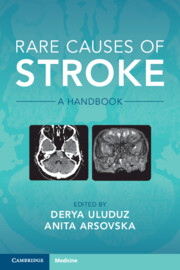Book contents
- Rare Causes of Stroke
- Rare Causes of Stroke
- Copyright page
- Contents
- Contributors
- Preface
- 1 Inflammatory Conditions
- 2 Infectious and Postinfectious Vasculitis
- 3 Hypercoagulable Causes of Stroke
- 4 Drug-Related Stroke
- 5 Hereditary and Genetic Causes of Stroke
- Chapter 5.1 Genetic Collagen Disorders
- Chapter 5.1 Chapter
- Chapter 5.2 Genetic Small-Vessel Diseases
- Chapter 5.3 Genetic Metabolic Diseases
- 6 Rare Causes of Cardioembolism
- 7 Vasospastic Conditions and Other Vasculopathies
- 8 Other Non-inflammatory Vasculopathies
- 9 Venous Occlusive Conditions
- 10 Bone Disorders and Stroke
- Index
- References
Chapter 5.1 - Chapter
from 5 - Hereditary and Genetic Causes of Stroke
Published online by Cambridge University Press: 06 October 2022
- Rare Causes of Stroke
- Rare Causes of Stroke
- Copyright page
- Contents
- Contributors
- Preface
- 1 Inflammatory Conditions
- 2 Infectious and Postinfectious Vasculitis
- 3 Hypercoagulable Causes of Stroke
- 4 Drug-Related Stroke
- 5 Hereditary and Genetic Causes of Stroke
- Chapter 5.1 Genetic Collagen Disorders
- Chapter 5.1 Chapter
- Chapter 5.2 Genetic Small-Vessel Diseases
- Chapter 5.3 Genetic Metabolic Diseases
- 6 Rare Causes of Cardioembolism
- 7 Vasospastic Conditions and Other Vasculopathies
- 8 Other Non-inflammatory Vasculopathies
- 9 Venous Occlusive Conditions
- 10 Bone Disorders and Stroke
- Index
- References
Summary
Neurofibromatosis type 1 (NF1) is the most common of the neurocutaneous syndromes, transmitted by autosomal dominant trait. Café-au-lait macules are the most frequently seen skin lesions, and skin fold freckling is usually the second sign to appear. The clinical manifestations are highly variable, and it can involve not only the nervous systems and the skin, but also some bones as well as the ophthalmological (Lisch nodules, glaucoma, and optic glioma), gastrointestinal, endocrine and vascular systems. In mild cases, cafe au lait spots and subcutaneous neurofibromas are the only features. Vascular abnormalities in NF1 can rarely occur in peripheral or cerebral vessels, and pathologically include regions of intimal proliferation and fibromuscular changes in small arteries. Strokes may either be caused by aneurysms or vessels affected by stenosis, or hypertension complications. Moyamoya syndrome (MMS) is the most common cerebral vasculopathy among children with NF1. The features of MMS are similar between patients with NF1 and those without. The phenotype-genotype features of NF1 are similar between children with MMS and those without. No associations are found between vasculopathy and common clinical features of NF1, including optic pathway glioma, plexiform neurofibroma, skeletal abnormalities, attention-deficit hyperactivity disorder
Keywords
- Type
- Chapter
- Information
- Rare Causes of StrokeA Handbook, pp. 220 - 227Publisher: Cambridge University PressPrint publication year: 2022

